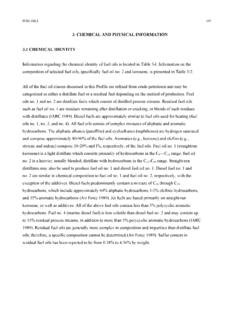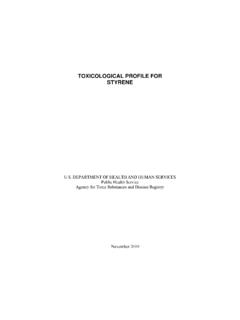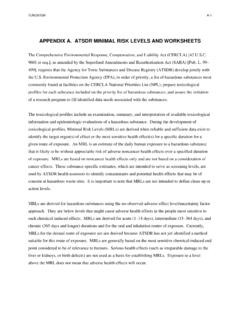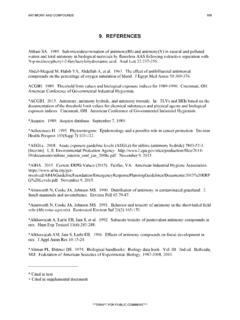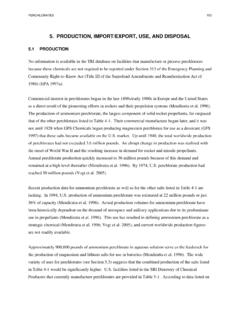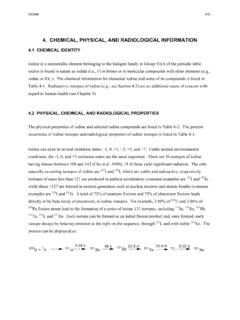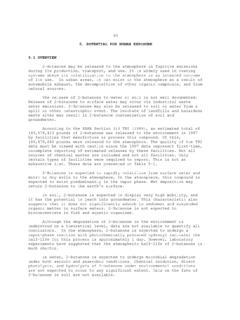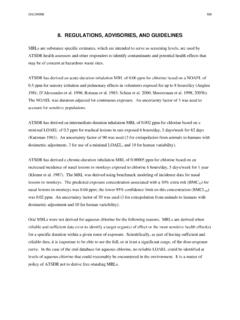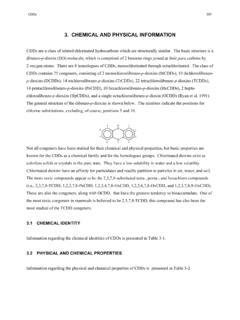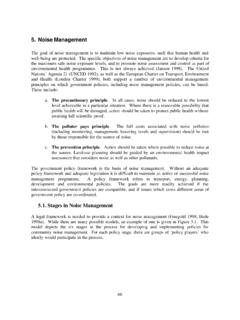Transcription of TOXICOLOGICAL PROFILE FOR POLYCYCLIC AROMATIC …
1 TOXICOLOGICAL PROFILE FOR POLYCYCLIC AROMATIC HYDROCARBONS DEPARTMENT OF HEALTH AND HUMAN SERVICES Public Health Service Agency for Toxic Substances and Disease Registry August 1995 ii PAHsDISCLAIMER The use of company or product name(s) is for identification only and does not imply endorsement by the Agency for Toxic Substances and Disease Registry. PAHs iii UPDATE STATEMENT A TOXICOLOGICAL PROFILE for POLYCYCLIC AROMATIC Hydrocarbons was released in December 1990. This edition supersedes any previously released draft or final PROFILE . TOXICOLOGICAL profiles are revised and republished as necessary, but no less than once every three years. For information regarding the update status of previously released profiles, contact ATSDR at: Agency for Toxic Substances and Disease Registry Division of Toxicology/Toxicology Information Branch 1600 Clifton Road NE, E-29 Atlanta, Georgia 30333 1 PAHs1.
2 PUBLIC HEALTH STATEMENT This statement was prepared to give you information about POLYCYCLIC AROMATIC hydrocarbons (PAHs) and to emphasize the human health effects that may result from exposure to them. The Environmental Protection Agency (EPA) has identified 1,408 hazardous waste sites as the most serious in the nation. These sites make up the National Priorities List (NPL) and are the sites targeted for long-term federal clean-up activities. PAHs have been found in at least 600 of the sites on the NPL. However, the number of NPL sites evaluated for PAHs is not known. As EPA evaluates more sites, the number of sites at which PAHs are found may increase. This information is important because exposure to PAHs may cause harmful health effects and because these sites are potential or actual sources of human exposure to PAHs.
3 When a substance is released from a large area, such as an industrial plant, or from a container, such as a drum or bottle, it enters the environment. This release does not always lead to exposure. You can be exposed to a substance only when you come in contact with it. You may be exposed by breathing, eating, or drinking substances containing the substance or by skin contact with it. If you are exposed to substances such as PAHs, many factors will determine whether harmful health effects will occur and what the type and severity of those health effects will be. These factors include the dose (how much), the duration (how long), the route or pathway by which you are exposed (breathing, eating, drinking, or skin contact), the other chemicals to which you are exposed, and your individual characteristics such as age, sex, nutritional status, family traits, lifestyle, and state of health.
4 WHAT ARE POLYCYCLIC AROMATIC HYDROCARBONS? PAHs are a group of chemicals that are formed during the incomplete burning of coal, oil, gas, wood, garbage, or other organic substances, such as tobacco and charbroiled meat. There are more than 100 different PAHs. PAHs generally occur as complex mixtures (for example, as part of combustion products such as soot), not as single compounds. PAHs usually occur 2 PAHs1. PUBLIC HEALTH STATEMENT naturally, but they can be manufactured as individual compounds for research purposes; however, not as the mixtures found in combustion products. As pure chemicals, PAHs generally exist as colorless, white, or pale yellow-green solids.
5 They can have a faint, pleasant odor. A few PAHs are used in medicines and to make dyes, plastics, and pesticides. Others are contained in asphalt used in road construction. They can also be found in substances such as crude oil, coal, coal tar pitch, creosote, and roofing tar. They are found throughout the environment in the air, water, and soil. They can occur in the air, either attached to dust particles or as solids in soil or sediment. Although the health effects of individual PAHs are not exactly alike, the following 17 PAHs are considered as a group in this PROFILE : acenaphthene acenaphthylene anthracene benz[a]anthracene benzo[a]pyrene benzo[e]pyrene benzo[b]fluoranthene benzo[g,h,i]perylene benzo[j]fluoranthene benzo[k]fluoranthene chrysene dibenz[a,h]anthracene fluoranthene fluorene indeno[ 1,2,3-c,d]pyrene phenanthrene pyrene These 17 PAHs were chosen to be included in this PROFILE because (1) more information is available on these than on the others.
6 (2) they are suspected to be more harmful than some of the others, and they exhibit harmful effects that are representative of the PAHs; (3) there is a greater chance that you will be exposed to these PAHs than to the others; and (4) of all the PAHs analyzed, these were the PAHs identified at the highest concentrations at NPL hazardous waste sites. 3 PAHs1. PUBLIC HEALTH STATEMENT More information can be found on the chemical and physical properties of PAHs in Chapter 3 and on their use and disposal in Chapter 4. WHAT HAPPENS TO POLYCYCLIC AROMATIC HYDROCARBONS WHEN THEY ENTER THE ENVIRONMENT? PAHs enter the environment mostly as releases to air from volcanoes, forest fires, residential wood burning, and exhaust from automobiles and trucks.
7 They can also enter surface water through discharges from industrial plants and waste water treatment plants, and they can be released to soils at hazardous waste sites if they escape from storage containers. The movement of PAHs in the environment depends on properties such as how easily they dissolve in water, and how easily they evaporate into the air. PAHs in general do not easily dissolve in water. They are present in air as vapors or stuck to the surfaces of small solid particles. They can travel long distances before they return to earth in rainfall or particle settling. Some PAHs evaporate into the atmosphere from surface waters, but most stick to solid particles and settle to the bottoms of rivers or lakes.
8 In soils, PAHs are most likely to stick tightly to particles. Some PAHs evaporate from surface soils to air. Certain PAHs in soils also contaminate underground water. The PAH content of plants and animals living on the land or in water can be many times higher than the content of PAHs in soil or water. PAHs can break down to longer-lasting products by reacting with sunlight and other chemicals in the air, generally over a period of days to weeks. Breakdown in soil and water generally takes weeks to months and is caused primarily by the actions of microorganisms. For more information on what happens to PAHs in the environment see Chapter 5. HOW MIGHT I BE EXPOSED TO POLYCYCLIC AROMATIC HYDROCARBONS?
9 PAHs are present throughout the environment, and you may be exposed to these substances at home, outside, or at the workplace. Typically, you will not be exposed to an individual PAH, but to a mixture of PAHs. 4 PAHs1. PUBLIC HEALTH STATEMENT In the environment, you are most likely to be exposed to PAH vapors or PAHs that are attached to dust and other particles in the air. Sources include cigarette smoke, vehicle exhausts, asphalt roads, coal, coal tar, wildfires, agricultural burning, residential wood burning, municipal and industrial waste incineration, and hazardous waste sites. Background levels of some representative PAHs in the air are reported to be nanograms per cubic meter (ng/m3; a nanogram is one-millionth of a milligram) in rural areas and ng/m3 in urban areas.
10 You may be exposed to PAHs in soil near areas where coal, wood, gasoline, or other products have been burned. You may be exposed to PAHs in the soil at or near hazardous waste sites, such as former manufactured-gas factory sites and wood-preserving facilities. PAHs have been found in some drinking water supplies in the United States. Background levels of PAHs in drinking water range from 4 to 24 nanograms per liter (ng/L; a liter is slightly more than a quart). In the home, PAHs are present in tobacco smoke, smoke from wood fires, creosote-treated wood products, cereals, grains, flour, bread, vegetables, fruits, meat, processed or pickled foods, and contaminated cow s milk or human breast milk.
